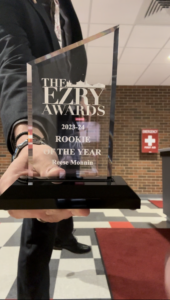On Sept. 6, Antioch College opened their newly-renovated 44,000 square-foot wellness center.
The project encompassed the renovation between existing structures. Antioch, which reopened its doors in 2012 after closing in 2007, is hoping the building will help attract students in order to boost enrollment.
“We are, after all, a start-up,” the new director of the wellness center, Monica Hasek, said.
The new facility includes “a healthy grab and go snack bar,” a gender neutral locker room facility, and the absence of televisions. Furthermore, Antioch anticipates this building to be Leadership in Energy and Environmental Design (LEED) certified, which, according to the LEED website, indicates that the “building saves money and resources, and has a positive impact on the health of occupants while promoting renewable, clean energy.”
Hasek also said that “building a bridge between the college and community” is a major goal of the new project. She estimates that nearly 300 Yellow Springs residents have already signed up to use the new facility. Each household membership costs $750 per year, and the wellness center also offers single-day use for a fee of $5 per entrant.
This project comes at a time when Wittenberg University has taken steps to limit unauthorized use of its own fitness facility. Beginning last year, entrants to the HPER Center were asked to show their Wittenberg IDs to enter the facility, as membership is reserved for students, alumni, and faculty. There is also no existing option for a member of the community to pay for single-day use of the facility.
When asked about the policy shifts, Wittenberg’s Assistant Athletic Director for Facilities and Operations, Maigen Larsen, said that the changes are being made in the interest of those who use the facility.
“Our goal is to create a more safe and secure environment for HPER members,” Larsen, who overlooked the policy changes, said. “The HPER Center is working hard to improve the experience of the students and HPER members that use Wittenberg’s facility.”
While the new wellness center at Antioch was not publicly financed, the Village Council waived a fee of several thousand dollars to help facilitate the project’s timely completion. Antioch provided the majority of the nearly $8 million that were required for the new center. So far, $700,000 has been raised in support of the project by a community group via market-based research.
Lori Askeland, Wittenberg professor of English and a member of the Village Council of Yellow Springs, when comparing the fitness centers’ respective relationships, described Wittenberg and Springfield’s as more “taken for granted.” While Springfield and Wittenberg are not totally co-dependent, Askeland said that “the more Springfield can be a place that people want to spend time in, [and] live in, the better it will be for Wittenberg.”
Askeland also pointed to the Hagen Center, along with other efforts Wittenberg tries as attempts to work with the community. For the Wittenberg community’s southern neighbors, the importance of the relationship between city and school was made clear after Antioch’s closing in 2007 forced the Yellow Springs community to face “a graveyard in the middle of town.”
Some of the differences Askeland attributed to the difference in populations.
“Antioch has only 140 students and could not support that facility themselves, ” Askeland said, using the new wellness center as an example.
Geography is also a likely a factor, according to Askeland, “Someone could live in Springfield and never come through Wittenberg,” whereas Antioch is in the heart of the small village of Yellow Springs.
The new wellness center is located at the corner of Livermore and E. South College Street in Yellow Springs, Ohio, and, as mentioned before, memberships are available to the public.





